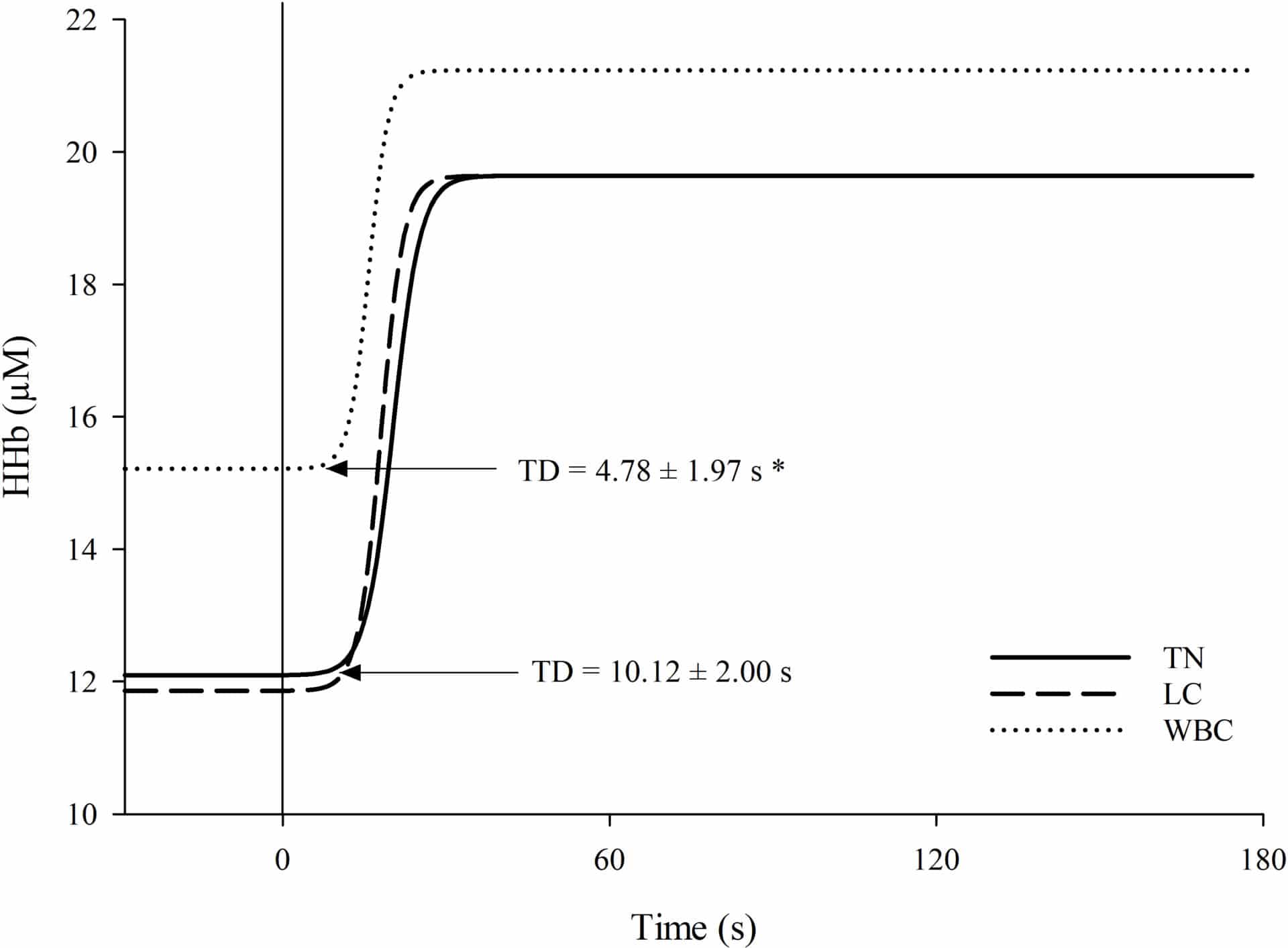Temperature changes peripheral and core tissue dynamics, resulting in profound effects on blood flow and subsequent oxygen transport and uptake (Yanagisawa et al., 2007). Increases in muscle temperature (Tm) suggest limited influences on pulmonary oxygen uptake kinetics (VO2p), while decreases in Tm, instead, have indicated a slower VO2p kinetic response due to reduced oxidative reactions, during low exercise intensity following lower-body cooling (Koga et al., 1997; Shiojiri et al., 1997). We are unaware if these changes occur locally or via systemic cooling, and if this is parallel in muscle oxygen uptake responses (VO2m). This study investigated VO2p and VO2m kinetics in response to core (Tc) and Tm cooling of the vastus lateralis muscle during exercise. Eight males (mean ± SD; 25 ± 5.5 years, 175 ± 6.9 cm, 76 ± 8.0 kg, 17 ± 3.0 %BF, 53 ± 6.1 mL/kg/min VO2max) performed two rest-to-exercise sessions at 80% of the first ventilatory threshold for three minutes on a cycle ergometer, in the following three conditions: thermoneutral (TN: no change in Tc and Tm), local leg cooling (LC: no change in Tc and Tm decreased by 6°C ), and whole-body cooling (WBC: Tc decreased by 1°C and Tm decreased by 6°C). Tm was measured with an intramuscular temperature probe. Cardiorespiratory variables were assessed via metabolic cart. Cardiac output was assessed via impedance cardiography. Near-infrared spectroscopy was used to evaluate concentration changes in oxy/deoxygenated hemoglobin and was combined with venous and arterial occlusions to calculate VO2m and muscle blood flow (Qm). One-way RM ANOVA were used to assess differences in VO2p, deoxygenated hemoglobin (HHb) and Q kinetics (baseline, amplitude, time delay; TD, and time constant; τ), relative VO2p, VO2m, Qm, Tc and Tm were assessed at baseline, pre and post exercise with two-way RM ANOVA. Statistical significance was set at p<0.05. Despite lower Tc and Tm, higher baseline values of VO2p in WBC vs. TN (+3.3 ± 2.67 mLO2/kg/min) and LC (+3.0 ± 2.98 mLO2/kg/min) were observed. VO2p kinetics TD and τ remained similar across all conditions. Relative VO2p in WBC was higher than TN (+2.7 ± 1.78 mLO2/kg/min). There were no changes in cardiac output kinetics. A shorter HHb kinetics TD was observed in WBC vs. TN (-5.3 ± 3.32 s), and a decrease in Qm in WBC vs. TN (-1.7 ± 1.73 mL/min/100mL) and LC (-0.6 ± 1.06 mL/min/100mL). HHb kinetics τ did not change and relative changes in VO2m were not different. These results indicate faster VO2m kinetics, seen by a shorter TD in WBC during moderate intensity exercise. The higher VO2p demand in WBC suggests a greater recruitment of muscle mass to compensate for the limited rate of oxidative reactions following cooling, and could explain the lack of differences in kinetics values (Ferretti, 1992). Future investigations should examine the complex role that exercise intensity has on oxidative reactions under systemic and local cooling.
Physiology 2019 (Aberdeen, UK) (2019) Proc Physiol Soc 43, PC110
Poster Communications: Whole-body cooling results in reduced muscle blood flow but faster muscle oxygen uptake kinetics
N. Beckett-Brown1,2, O. Seresse1, A. McCue1,2, J. Peltonen3, L. Vilén5, D. Marsh4, D. MacLean4, D. Gagnon1,2
1. Laboratory of Environmental Exercise Physiology, School of Human Kinetics, Faculty of Health, Laurentian University, Sudbury, Ontario, Canada. 2. Canter for Research in Occupational Safety and Health, Laurentian University, Sudbury, Ontario, Canada. 3. Department of Sport and Exercise Medicine, Clinicum, University of Helsinki, Helsinki, Finland. 4. Northern Ontario School of Medicine, Sudbury, Ontario, Canada. 5. University of Jyväskylä, Jyväskylä,, Western and Central Finland, Finland.
View other abstracts by:
Where applicable, experiments conform with Society ethical requirements.


